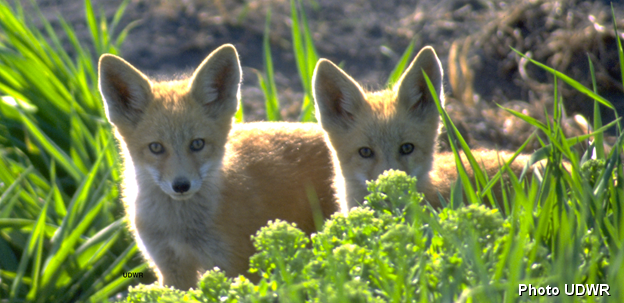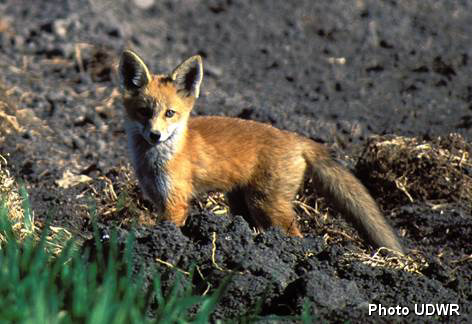Be Aware › Foxes, Red

The red fox, Vulpes vulpes, has a wide distribution throughout North America, Europe, and Asia. Red foxes are common in Utah, and are found in open and semi-open habitats, although they occasionally occur in heavily forested areas, cities, and suburban settings.
The red fox is a member of the canid family, which includes wolves, coyotes, and domestic dogs. Contrary to its name, the red fox is not always red, but can be any shade between red and black. A red fox can be distinguished from other fox species by the characteristic white tip on the end of its tail.

Foxes are opportunistic omnivores and skilled scavengers. They feed mostly on small mammals, insects, amphibians, fish, fruits, berries, nuts, eggs and carrion.
Red foxes may be active any time, day or night, but are most active at dawn and dusk. Screeching yowls, barking, yipping and howling are common vocalizations. Fox also have a very strong musk odor.
The breeding season occurs from mid-January to early February. Red foxes usually have a single annual litter of 4–5 kits. Fox kits, or pups, are born from March to May in dens dug in the ground or under rocks or structures. Red fox may dig their own dens or use abandoned burrows. They usually have one primary den for their young, called a natal den, which may be used year after year.
The young begin to hunt with the adults at about 8–12 weeks old. They stay with their parents through the spring and summer months and disperse to find their own territories by the fall.
Utah Legal Status

Red fox are classified as protected wildlife and as furbearers. However, they can be taken year-round with no license required.
Avoid Conflicts with Red Foxes
Utah is home to an abundance of wildlife, including red foxes, which can be exciting to see. But remember: Always observe from a safe distance.
Do not try to feed, approach or chase foxes.
The best way to avoid conflicts with a red fox is to prevent issues from developing in the first place. Here are a few tips:
- Red foxes will occasionally scavenge in garbage. Secure trash in a locked receptacle and put it out the morning of pick up.
- Remove attractants from your property, including pet food, water sources, bird feeders and fallen fruit.

- Trim vegetation around your yard to reduce hiding places.
- As a deterrent, install outdoor and motion sensitive lighting around your property. Lights also make approaching foxes visible.
- If a fox is on your property, make it feel unwelcome: Yell, bang pots and pans, spray it with a hose or turn on sprinklers.
- Supervise pets when they are outside, especially at dawn and dusk.
- Never leave pets outside after dark.
- Keep dogs leashed, especially when on trails and in open areas.
- Never let your dog chase or “play” with foxes.
- Cats should be kept indoors.
- Use electric fencing to help keep fox away from pets and livestock.
If you have an encounter with an aggressive red fox, please alert the Utah Division of Wildlife Resources office near you. If the encounter occurs after hours or on a weekend, please call your local police department, who can call a conservation officer to handle the situation.

